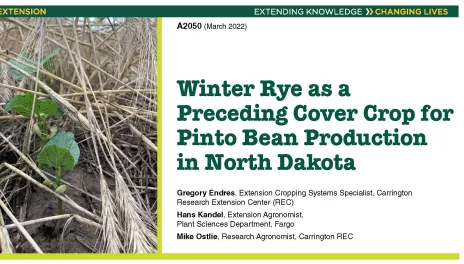Winter Rye as a Preceding Cover Crop for Dry Bean
August will be a busy month for harvest, starting with small grain, continuing with other cool-season crops, followed by row crops. If dry bean is planned for 2023 following this year’s small grain rotation, an excellent cover crop option that will provide benefits when planted this fall and continue to provide benefits next spring and early summer is winter (cereal) rye.
Winter rye is a common cover crop used in North Dakota with many advantages when properly managed. Expected advantages when established prior to dry bean production and with timely termination include reduction in soil erosion, supplemental weed management, utilization of excess soil moisture and improved efficiency with direct harvest of bean seed (e.g., timely harvest and clean seed).
A study commenced at the Carrington REC during fall 2017 seeded winter rye to provide living ground cover in the fall and spring prior to pinto bean production; we experienced benefits as described above. Study objectives included determining the optimum time for terminating rye based on bean planting date, assessing weed suppression and measuring productivity of the bean crop. The study was completed in 2021, providing a four-year database on the production strategy.
The following is a summary of the research:
- Pinto bean seed yield with preplant-terminated rye was similar to yield with the conventional-tilled production system check.
- Delay in terminating rye until near or after dry bean planting allowed the rye to deplete topsoil moisture that was needed to timely establish bean plants, and negatively impacted bean plant development, canopy closure and seed yield.
- Dry topsoil conditions during early bean plant establishment throughout the years of the study indicate rye termination at least two weeks before bean planting is suggested with similar environmental conditions as experienced in Carrington.
- Delayed rye termination provided benefits of increased ground cover during the crop season and weed control similar as achieved with pre-emergence herbicides. Weed suppression with rye can be considered another management tool to supplement herbicides and other cultural control methods.
- Adequate topsoil moisture during bean planting and plant establishment would allow extended benefits of the live rye cover crop at planting (“green-planted beans”) while maintaining seed yield potential. Soil moisture status and precipitation forecast should be taken into consideration when determining the best time to terminate rye at a particular location.
Details can be read in the NDSU Extension publication A2050 Winter Rye as a Preceding Cover Crop for Pinto Bean Production in North Dakota, which is available online at https://www.ndsu.edu/agriculture/extension/publications/winter-rye-preceding-cover-crop-pinto-bean-production-north-dakota or at NDSU Extension county offices.
Greg Endres
Gregory.Endres@ndsu.edu
Extension Cropping Systems Specialist

